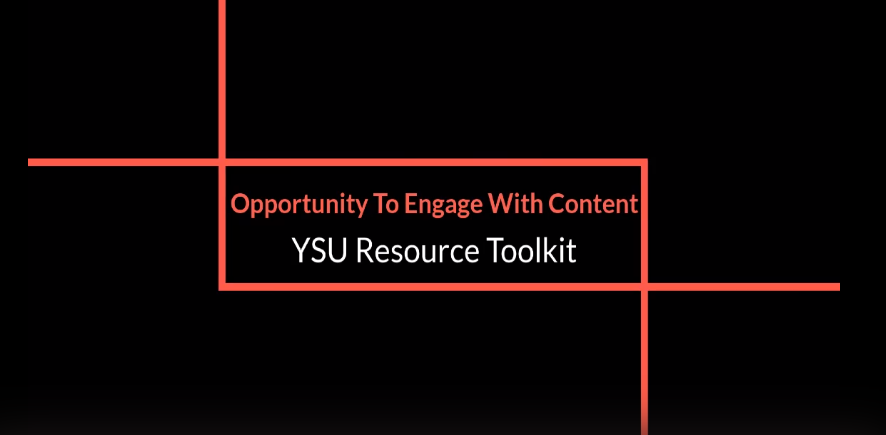-
-
Colleges
-
-
Student Experience Greek Life Housing & Dining Health & Recreation Our Campus Community Engagement Athletics
-
I want to provide an OPPORTUNITY TO ENGAGE WITH CONTENT.

Click on the image above to view the video!
This video is a walkthrough of the strategies, technology, and resources found on this outcome webpage. It was recorded during the summer Resource Toolkit Workshop Series (July 2020). You can access the video using your YSU credentials. Please contact atkaufman@ysu.edu if you are unable to access the video.
You've likely heard the phrase ACTIVE LEARNING before, but might not be familiar with what exactly it is. Active learning includes any "activities that students do to construct knowledge and understanding." These types of activities frequently engage students in higher-order levels of thinking. There are decades of robust evidence that support including active learning strategies as a way to increase learning, as opposed to lecture-only courses (Freeman et al., 2014). Additionally, active learning promotes learning for all students and is an effective strategy for creating a more equitable classroom (Haak et al., 2011; Law et al, 1999); Schneider, 2000) (Brame, 2016).
There are several strategies you can implement to provide opportunities for your students to engage with course content. Active learning techniques are a common way to involve students in the learning process to create a learner-centered environment. Visit this guide for an extensive list of active learning techniques.
- Active Learning Examples to Incorporate in Class
- The Pause Procedure: Pause for a few minutes every 15 minutes of class to have students write everything they can remember from the previous segment. They can submit this to you via Blackboard or post in a discussion board.
- Mini-Maps: Give students a shortlist of key terms (10 or less) and ask them to arrange the terms into a logical structure - with arrows and words to show relationships. You can utilize Microsoft Whiteboard or have them take a picture where their phones and upload their map into Blackboard.
- Student-Generated Test Questions: Provide students with course learning outcomes and Bloom's taxonomy. Have students work in breakout group discussion boards to create test questions that address various learning levels. Share students questions/answers with the rest of the course as a study guide.
- A Fully Flipped Classroom
In a flipped classroom, students review content before the scheduled class session. Class time is reserved for higher-level thinking, problem-solving, and discussions. This model allows you to take advantage of class time to focus on engaging learning activities as opposed to passive lectures.
What students do on their own:
- Watch recorded lectures before the live class.
- Review instructional content (articles, chapter readings).
- Complete a small assignment before class to ensure engagement with the required content. This also allows you to adjust your class activities based on how well students grasp the content.
- Perform research and prepare questions to ask in class.
What students do in class:
- Engage in discussions or debates with peers.
- Practice or demonstrate the skills learned.
- Facilitate individual or group presentations.
Students benefit from interacting with content from various sources, tones, and points of view. This allows students to engage with content on various platforms. While creating your own content adds a level of personalization to the course, try to incorporate video and media from other sources as well. Students are more likely to engage with content that is presented in easily digestible “chunks”. Break recorded lectures up into smaller segments. Try to limit your video to under 15 minutes. You can post multiple videos of your lecture as well as include other forms of content.
